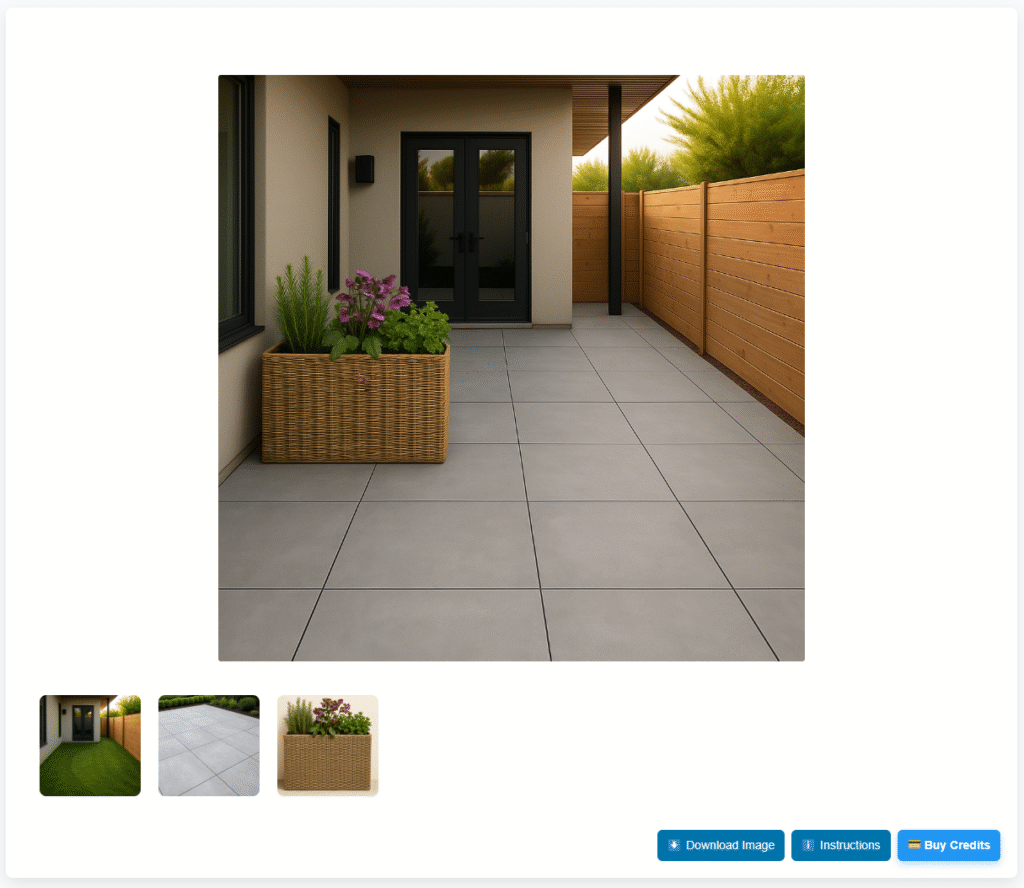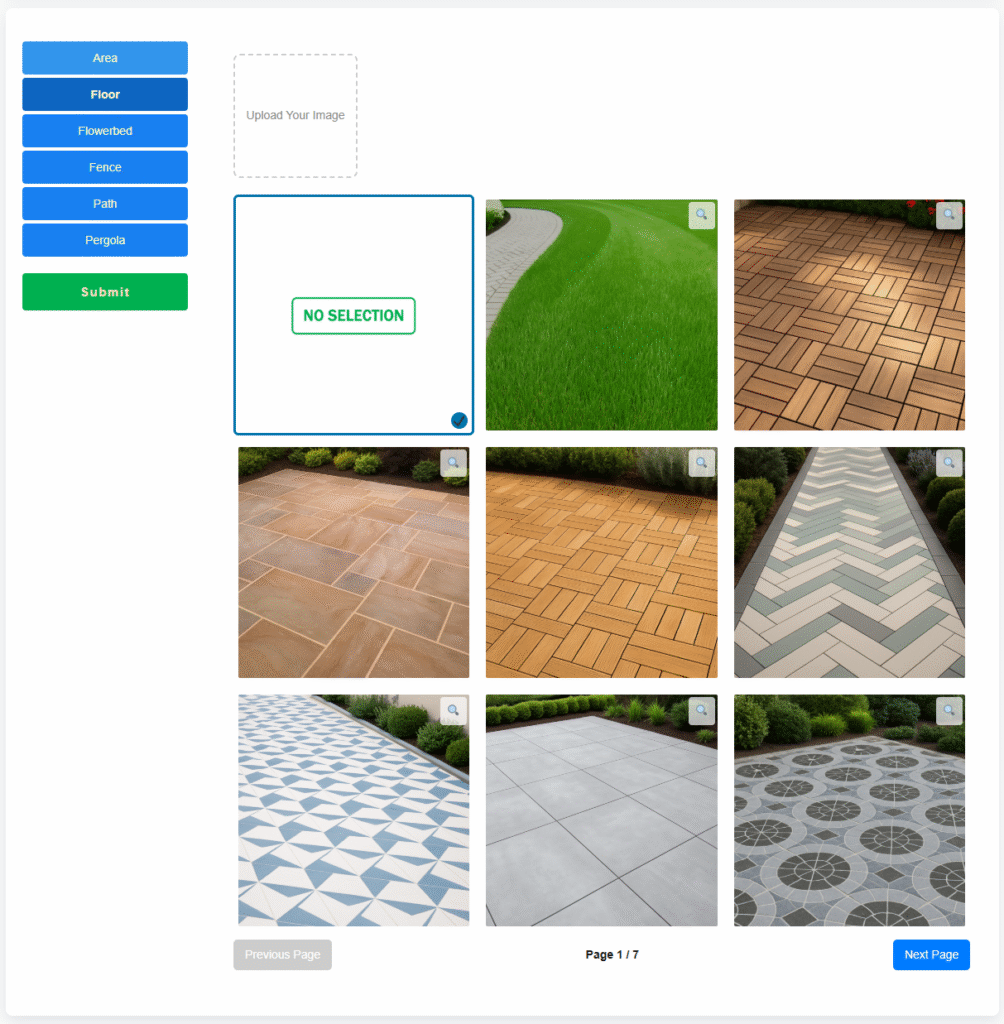Designing your dream garden starts with one key decision: choosing the right style. From structured formal gardens to relaxed rustic retreats, each type reflects a unique philosophy of outdoor living. This guide explores five popular garden styles and shows how to visualize them with YardCraft, an AI garden design tool.
1. The Formal Garden — Symmetry, Structure, and Balance
Formal gardens are inspired by classical European landscapes. Their defining characteristic is geometric symmetry: paths, hedges, and flowerbeds are arranged with precision to create a sense of order and visual balance.
Key features: straight, clearly defined lines; mirrored layouts; box hedges and stone borders; central focal points such as fountains or statues.
Best for: medium to large gardens or front yards where structure and elegance are desired.
Maintenance level: high — regular trimming and pruning are required to maintain formal lines and symmetry.
Try it in YardCraft: select Stone Flooring or Porcelain Tiles, add a Formal Border Flowerbed, and finish with a classic pergola or fountain element. YardCraft will render a refined, palace-like layout.
2. The Rustic Garden — Natural Beauty and Effortless Charm
The rustic garden embraces organic shapes, texture, and a relaxed feel: imagine wildflowers, gravel paths, and reclaimed wood accents. It values imperfection and variety over rigid order.
Key features: irregular paths, mixed perennial beds, and natural materials like wood and stone.
Best for: larger or countryside gardens that benefit from a casual, natural aesthetic.
Maintenance level: low to moderate — plants and materials are chosen to fit a more self-sustaining approach.
Try it in YardCraft: choose Gravel Floor with a Winding Path and a Mixed Perennial Flowerbed. Add a rustic pergola to complete the look.
3. The Modern Garden — Minimalism Meets Functionality
Modern gardens emphasize simplicity, clean lines, and functional design. Materials like concrete, metal, and porcelain are used alongside structured planting to create a coherent, contemporary space.
Key features: rectilinear layouts, contrasting materials, subdued color palettes, and architectural planting.
Best for: urban homes, rooftops, and compact backyards.
Maintenance level: moderate — hardscape elements dominate and plantings are often architectural and low-maintenance.
Try it in YardCraft: select Gray Porcelain Tiles, a Metal Fence, and a Modern Pergola. Add a minimalist path and let YardCraft create a sleek, contemporary outdoor room.
4. The Perennial Garden — Seasonal Color and Low Maintenance
Perennial gardens focus on long-term planting plans that deliver color and texture across multiple seasons. By combining species with staggered bloom times, a perennial garden remains attractive year-round.
Key features: layered planting (tall at the back, low at the front), sequential bloom planning, and a mix of foliage textures.
Best for: medium to large gardens where ongoing seasonal interest is desired.
Maintenance level: low once established — perennials require less replanting and can form stable displays over time.
Try it in YardCraft: pick a Mixed Perennial Bed and a Stepping Stone Path. Use the preview to visualize spring bulbs, summer lavender, and autumn asters in one cohesive plan.
5. The Courtyard Garden — Intimate Spaces for Urban Living
Courtyard gardens provide private, enclosed outdoor rooms for relaxation and socializing. They focus on maximizing comfort and atmosphere within limited space, using vertical planting, paving, and well-placed seating.
Key features: paved surfaces, container planting, vertical green walls, and intimate lighting.
Best for: small urban courtyards, patios, and inner-city back gardens.
Maintenance level: low — these designs are intended for ease and frequent use.
Try it in YardCraft: upload a courtyard photo as the Area, choose Natural Stone Flooring and Potted Flowerbeds, and apply a modern fence for privacy. YardCraft will render a realistic courtyard preview for planning or staging.
How to Use YardCraft to Simulate Any Style
YardCraft enables fast visual experimentation without the commitment of materials or labor. Follow these steps:
- Start with Area: upload a photo of your garden or select a blank layout.
- Define Floor & Path: pick primary surfaces (tiles, wood, gravel) and circulation routes.
- Choose Flowerbeds & Fences: set planting style and border definition.
- Add Structures: pergolas as focal elements.
- Preview & Adjust: iterate until proportions and materials feel right. If you do not want an element, just select “No Selection” in that category.
After “submit”, YardCraft blends your choices into a lifelike image, letting you compare designs and save or share options before making physical changes.


Common Design Mistakes to Avoid
Even with a strong concept, planning errors can reduce a garden’s functionality and visual coherence. Common pitfalls include:
- Overcrowding small spaces: large structures in a small garden can overwhelm.
- Poor pathway flow: awkward routes reduce usability. Choose paths that guide natural movement.
- Mixing clashing materials: inconsistent textures look chaotic. Preview material pairings first.
- Neglecting color balance: concentrate bold color in focal areas and use neutral backgrounds elsewhere.
